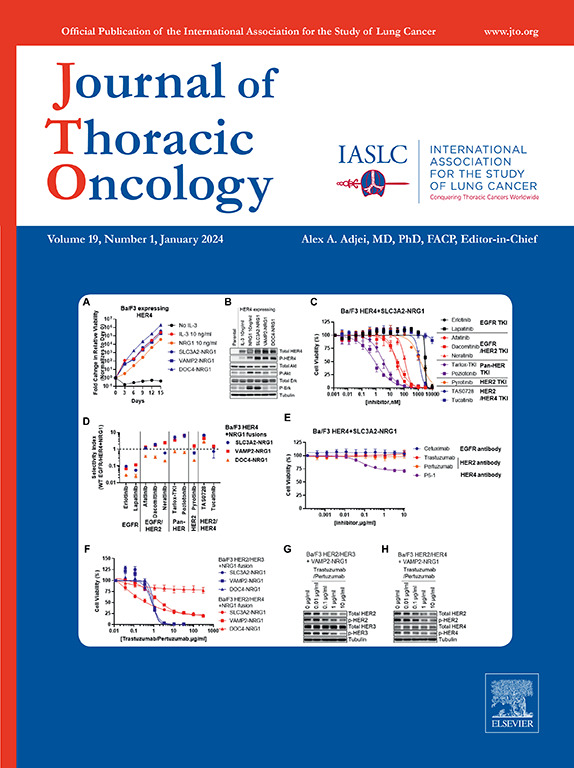Impact of Comorbidities on the Mortality Benefits of Lung Cancer Screening: A Post-Hoc Analysis of the PLCO and NLST Trials
IF 21
1区 医学
Q1 ONCOLOGY
引用次数: 0
Abstract
Objectives
To evaluate how comorbidities affect mortality benefits of lung cancer screening (LCS) with low-dose computed tomography.
Methods
We developed a comorbidity index (Prostate, Lung, Colorectal, and Ovarian comorbidity index [PLCO-ci]) using LCS-eligible participants’ data from the Prostate, Lung, Colorectal, and Ovarian (PLCO) trial (training set) and the National Lung Screening Trial (NLST) (validation set). PLCO-ci predicts five-year non–lung cancer (LC) mortality using a regularized Cox model; with performance evaluated using the area under the receiver operating characteristics curve. In NLST, LC mortality (per original publication) was compared between low-dose computed tomography and chest radiograph arms across the PLCO-ci quintile (Q1–5) using a cause-specific hazard ratio (csHR) with 95% confidence intervals (CIs).
Results
Analyses included 34,690 PLCO and 53,452 NLST participants (mean age: 62 y [±5 y] and 61 y [±5 y], 58% and 59% male individuals, and 39% and 41% active smokers, respectively). PLCO-ci predicted five-year non-LC mortality with an area under the receiver operating characteristics curve of 0.72 (95% CI: 0.71–0.74) in PLCO and 0.69 (95% CI: 0.67–0.70) in NLST. In NLST, at a median follow-up of 6.5 years, LC mortality was significantly reduced for participants with intermediate comorbidity (Q2, Q3, and Q4): csHR 0.62 (95% CI: 0.41–0.95), 0.68 (95% CI: 0.48–0.96), and 0.72 (95% CI: 0.54–0.96) respectively, with a nonstatistically significant reduction for Q1 (csHR = 0.72, 95% CI: 0.45–1.17) and no reduction for Q5 participants (csHR = 0.99, 95% CI: 0.79–1.23). Participants in Q2, Q3, and Q4 (60%) accounted for 89% of LC deaths averted among all NLST participants. Q1 participants had low LC incidence, whereas Q5 had higher localized LC lethality, more squamous cell carcinomas, and untreated LC.
Conclusions
The PLCO-ci developed in this work shows that individuals with intermediate comorbidity benefited the most from LCS, highlighting the need of addressing comorbidities to achieve LC mortality benefits.
合并症对肺癌筛查死亡率获益的影响:PLCO和NLST试验的事后分析
假设:评估合并症如何影响低剂量计算机断层扫描(LDCT)肺癌筛查(LCS)的死亡率。方法:我们使用来自前列腺、肺、结直肠和卵巢(PLCO)试验(训练集)和国家肺筛查试验(NLST)(验证集)的符合lcs条件的参与者的数据制定了合并症指数(PLCO-ci)。PLCO-ci使用正则化Cox模型预测5年非肺癌(LC)死亡率;用ROC曲线下面积(ROCAUC)来评价其性能。在NLST中,使用95%可信区间的病因特异性风险比(csHR)比较LDCT和胸部x线臂在PLCO-ci五分位数(Q1-5)上的LC死亡率(每篇原始出版物)。结果:分析包括34,690名PLCO和53,452名NLST参与者(平均年龄:62(±5)岁和61(±5)岁,58%和59%的男性,39%和41%的活跃吸烟者)。PLCO-ci预测5年非lc死亡率,PLCO的ROCAUC [95%CI]为0.72 [0.71-0.74],NLST的ROCAUC [95%CI]为0.69[0.67-0.70]。在NLST中,中位随访时间为6.5年,伴有中度共病(Q2-Q3-Q4)的受试者LC死亡率显著降低:csHR [95% CI]分别为0.62[0.41-0.95]、0.68[0.48-0.96]和0.72[0.54-0.96],其中Q1受试者LC死亡率降低无统计学意义(csHR=0.72 [0.45-1.17]), Q5受试者LC死亡率无降低(csHR=0.99[0.79-1.23])。在所有NLST参与者中,Q2-Q3-Q4的参与者(60%)占LC死亡避免的89%。Q1参与者的LC发病率较低,而Q5参与者的局部LC致死率较高,鳞状细胞癌较多,未治疗的LC较多。结论:本研究开发的PLCO-ci显示,具有中度合并症的个体从LCS中获益最多,强调了解决合并症以实现LC死亡率获益的必要性。
本文章由计算机程序翻译,如有差异,请以英文原文为准。
求助全文
约1分钟内获得全文
求助全文
来源期刊

Journal of Thoracic Oncology
医学-呼吸系统
CiteScore
36.00
自引率
3.90%
发文量
1406
审稿时长
13 days
期刊介绍:
Journal of Thoracic Oncology (JTO), the official journal of the International Association for the Study of Lung Cancer,is the primary educational and informational publication for topics relevant to the prevention, detection, diagnosis, and treatment of all thoracic malignancies.The readship includes epidemiologists, medical oncologists, radiation oncologists, thoracic surgeons, pulmonologists, radiologists, pathologists, nuclear medicine physicians, and research scientists with a special interest in thoracic oncology.
 求助内容:
求助内容: 应助结果提醒方式:
应助结果提醒方式:


